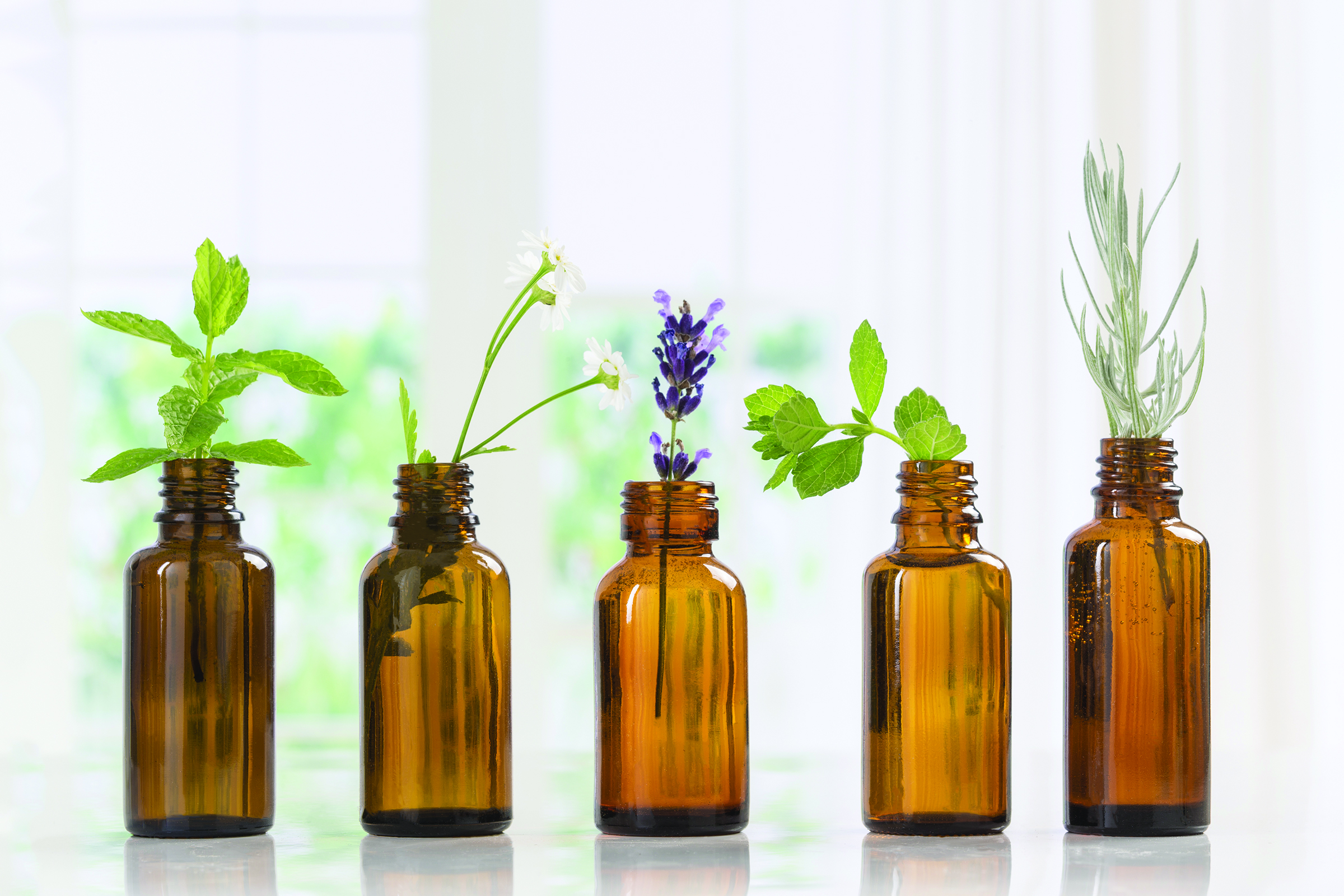Explore this option for enhancing well-being
Takeaways:
- Aromatherapy is a growing holistic therapeutic option, but is not typically taught in nursing school.
- Essential oils affect the hippocampus, activating memories and potentially producing mood-enhancing effects to reduce anxiety, anger, and fear.
- Nurses can develop integrative aromatherapy programs to enhance patient satisfaction and outcomes.
Aromatherapy—which uses plant-based essential oils (inhaled or applied topically) to achieve therapeutic effects—is a growing holistic healthcare trend, but most nurses will learn little about it in academic and clinical settings. This article helps bridge the knowledge gap for nurses who want to offer aromatherapy to their patients. (See Aromatherapy: A brief history.)
Aromatherapy: A brief history
Oil extraction from plants pre-dates recorded history, as evidenced by depictions of the practice in cave art and hieroglyphs.
- 4500 BCE: In Egypt, plant oils are used to make perfumes and medicines; cedarwood, clove, and cinnamon oils are used in embalming.
- 2957 BCE: In China, essential oils are used to support mood wellness and are included in medical texts.
- 400 BCE: Hippocrates includes essential oils as medicinal tools and uses them in baths and massages for their healing benefits.
- 1000 BCE: Persians are the first to distill essential oils using a process similar to what we use today.
- 1653: The Complete Herbal by Nicholas Culpeper (still considered a valuable resource and guide) details which essential oils can be used to treat specific ailments.
- 1930s: “Aromatherapy” is coined by Rene-Maurice Gattefosse, a French chemist, when he uses lavender oil to help heal his burn wounds.
- 1940s: During World War II, Jean Valnet, a French surgeon, uses essential oils to help heal soldiers’ battle wounds.
Essential oils: Definition and action
Essential oils are concentrated plant extracts obtained via mechanical pressing or distillation. Each type of oil affects the body differently. In general, particles are absorbed through the olfactory epithelium in the nasal cavity where they stimulate receptors that carry signals to the olfactory bulb; further signal processing allows the mitral cells in the bulb to transmit sensory signals to the olfactory cortex (activating the sense of smell) and onto the limbic system.
As described by Buckle, the brain’s complex limbic system helps to control emotions, regulate hunger and thirst, balance hormones, respond to pain and pleasure, and modulate the autonomic nervous system. Essential oils affect the hippocampus, which is part of the limbic system, including the memory-making process (one of the reasons why some aromas are linked with certain memories). This activation of memory associated with a particular aroma may explain, in part, some of the mood-enhancing effects of specific oils and why some oils may help relieve anxiety, anger, and fear as a result of their effect on the amygdala. Many essential oil components (terpenes, alcohols, esters, aldehydes, ketones, oxides, and lactones) work synergistically to create therapeutic effects. Agatonovic-Kustrin reported that some of these same compounds are found in allopathic and herbal medications.
A study by Fung and colleagues examined how essential oils affect gut metabolism and create shifts in body metabolites, which can lead to anxiolytic effects. Essential oils also may interact with pathogens, such as bacteria, viruses, and fungi, causing changes to their cellular structures. Although more research is needed, preclinical in vivo and in vitro trials by Agatonovic-Kustrin point toward the antimicrobial, antioxidant, anti-inflammatory, and anticancer effects of these compounds. The possible placebo effects of aromatherapy also might be considered with regard to how it may support well-being.
Common essential oils
Essential oils commonly used in clinical settings include lavender, peppermint, and orange.
Lavender, which can be used to decrease anxiety and foster sleep, contains linalool, a terpene that promotes relaxation, acts as an antispasmodic, and supports the immune system. A study by Ramsey and colleagues noted that lavender can be an endocrine disruptor and may enhance antidepressant and anxiolytic effects.
Peppermint oil has long been used as an antinausea intervention as well as a stimulant to enhance focus. Use peppermint cautiously on the skin as it can cause irritation. It shouldn’t be used on children under 30 months old or patients with atrial fibrillation.
Orange essential oil, expressed from the peel of the fruit, contains the terpene d-limonene, which supports energy levels, immune function, and mood. It also has been shown to have antidepressant and anxiolytic effects. Orange essential oil may cause phototoxicity, with photosensitivity noted up to 18 hours after application.
Essential oil application
Essential oils are applied topically via a diluted carrier oil, such as sweet almond, jojoba, apricot, fractionated coconut, olive, or avocado. The essential oil content should account for only 0.5% to 3% of the total blend (about 3 to 12 drops per ounce of finished product).
Essential oils can be applied to patients’ wrists or soles of their feet or by massaging the oil on any part of the body, avoiding mucus membranes and broken skin. Essential oils also can be added to bath water (or used in bath salts), hair conditioner, or body lotions or oils. Some companies offer patches that adhere to the skin, so the aroma can be inhaled over time. Oils also can be inhaled through an inhaler stick (these generally come “blank” and essential oil is applied) or circulated into the air via a diffuser.
Some companies claim that their essential oils can be ingested. However, the oral route should be avoided because of the rare risk of toxicity or allergic reactions.
Patient safety and education
Properly diluting an essential oil to less than 3% by volume when added to the carrier helps prevent skin reactions and systemic toxicity. Never apply oils to mucous membranes or near the eyes. For essential oils that can be phototoxic, patients should avoid exposing treated skin to sunlight. (The length of exposure avoidance varies by oil type.) All essential oils are flammable, so don’t use them near candles or any other flame.
Educate patients about the most commonly used oils. Review potential side effects and the importance of choosing products obtained from organically grown plants free of pesticides and contaminants. Also explain drug–drug interactions and when essential oils might not be appropriate. (See Choose wisely.)
Choose wisely
Some essential oils may interfere with other drugs (prescribed and over-the-counter) a patient is taking. In addition, aromatherapy may be contraindicated in patients diagnosed with certain conditions.
- Many essential oils (including cinnamon leaf, clary sage, and oregano) may induce or inhibit the liver’s cytochrome P450, which can result in metabolism changes of pharmaceutical or herbal medications that the liver metabolizes.
- Star anise, sweet fennel, and oregano may affect platelet aggregation and increase the activity of blood thinners such as warfarin, heparin, and aspirin.
- Orally ingesting some essential oils may reduce the effectiveness of monoamine oxidase inhibitors (clove, cinnamon) or create a hypoglycemic effect (geranium, fenugreek, turmeric, cinnamon).
- Essential oils shouldn’t be used on the skin close to transdermal patches because they may increase medication absorption rate.
- Oral ingestion of essential oils should be avoided. In particular, patients prone to seizures should avoid oral ingestion of pennyroyal, rosemary, Spanish lavender, tansy, yarrow, and wintergreen, which may induce seizures.
- Some cancers, such as breast and colorectal, may be estrogen-dependent. Patients with these cancers should avoid using aniseed, star anise, bitter fennel, myrtle, and clary sage, which can stimulate estrogen production.
- During pregnancy and breastfeeding, women should avoid using aniseed, star anise, cypress, dill, fennel, hyssop, and Spanish lavender. These essential oils may induce contractions and have a higher risk of toxicity, primarily in the first trimester.
Aromatherapy and nursing practice
Few healthcare systems use aromatherapy, but nurses can help develop these programs. Buckle’s Clinical Aromatherapy: Essential Oils in Healthcare, which describes the experiences of organizations that have developed and implemented clinical aromatherapy programs as part of an integrative health initiative, can serve as a helpful resource. Although it’s not necessary to pursue an aromatherapy credential, nurses may want to obtain certification in aromatherapy through the Institute of Integrative Aromatherapy, R.J. Buckle Associates, or the National Association for Holistic Aromatherapy. The Alliance of International Aromatherapists offers educational resources and guidelines.
To help ensure successful wide-scale implementation of an aromatherapy program, start with a small pilot project. Delineate the scope and objective of the project, garner stakeholder support, and determine budgets and resources. Perform a complete review of any harms or risks associated with specific essential oils (Tisserand and Young’s Essential Oils and Safety: A Guide for Healthcare Professionals is a useful reference), and select organic products from a reputable source. Essential oil companies should be able to verify the purity of their products (using gas chromatography and mass spectrometry tests) and the chemotype, the plant’s country of origin, extraction process used, and either a distillation or extraction date.
Establish program policies and procedures, determine who will be trained to administer aromatherapy (nurses, volunteers, or trained aromatherapists), develop patient education and assessment policies (including assessing patients for allergies), establish standardized electronic health record documentation processes, and measure patient outcomes.
Evaluate the effectiveness and safety of the aromatherapy program. Are patient nausea, pain, anxiety, and sleep improved? Is the intervention cost effective? Are patients expressing greater satisfaction with care received? In short, does the cost of providing aromatherapy benefit the patient by enhancing wellness and satisfaction?
A role for aromatherapy
Aromatherapy aligns with nursing’s holistic care theories and philosophies. Nurses should feel empowered to work with their organization and providers to create practices where they can provide aromatherapy at their discretion. Having an aromatherapy-certified holistic nurse take the lead or consult on processes will help ensure that aromatherapy within nursing practice remains evidence-based.
Patients who use essential oils properly in and out of clinical settings report positive experiences and minimal side effects, but more research is needed to support wide-spread acceptance. When applied appropriately, aromatherapy may have a role to play in helping some patients relieve stress, anxiety, nausea, and discomfort. AN
Carey S. Clark is a professor of nursing at Pacific College of Health and Science in New York City, New York.
References
Agatonovic-Kustrin S, Kustrin E, Gegechkori V, Morton DW. Anxiolytic terpenoids and aromatherapy for anxiety and depression. Adv Exp Med Biol. 2020;1260:283-96. doi:10.1007/978-3-030-42667-5_11
Balakrishnan A. Therapeutic use of peppermint: A review. J Pharm Sci Res. 2015;7(7):474-6.
Buckle J. Clinical Aromatherapy: Essential Oils in Healthcare. 3rd ed. London, UK: Churchill Livingstone; 2014.
Curious History. The history of essential oils. February 19, 2015. curioushistory.com/the-history-of-essential-oils
Deng C. Aromatherapy: Exploring olfaction. Yale Scientific. November 16, 2011. yalescientific.org/2011/11/aromatherapy-exploring-olfaction
Fung TKH, Lau BWM, Ngai SPC, Tsang HWH. Therapeutic effect and mechanisms of essential oils in mood disorders: Interaction between the nervous and respiratory systems. Int J Mol Sci. 2021;22(9):4844. doi:10.3390/ijms22094844
Joswiak D, Kinney ME, Johnson JR, et al. Development of a health system–based nurse-delivered aromatherapy program. J Nurs Adm. 2016;46(4):221-5. doi:10.1097/NNA.0000000000000327
Pergentino de Sousa D, de Almeida Soares Hocayen P, Andrade LN, Andreatini R. A systematic review of the anxiolytic-like effects of essential oils in animal models. Molecules. 2015;(20)10:18620-60. doi:10.3390/molecules201018620
Ramsey JT, Li Y, Arao Y, et al. Lavender products associated with premature thelarche and prepubertal gynecomastia: Case reports and endocrine-disrupting chemical activities. J Clin Endocrinol Metab. 2019;104(11):5393-5405. doi:10.1210/jc.2018-01880
Reis D, Jones T. Aromatherapy: Using essential oils as a supportive therapy. Clin J Oncol Nurs. 2017;21(1)16-9. doi:10.1188/17.CJON.16-19
Sharifi-Rad J, Sureda A, Tenore GC, et al. Biological activities of essential oils: From plant chemoecology to traditional healing systems. Molecules. 2017;(22)1:70. doi:10.3390/molecules22010070
Smith M, Kyle L. Holistic foundations of aromatherapy for nursing. Holist Nurs Pract. 2008;22(1):3-9. doi: 10.1097/01.HNP.0000306321.03590.32
Swamy MK, Akhtar MS, Sinniah UR. Antimicrobial properties of plant essential oils against human pathogens and their mode of action: An updated review. Evid Based Complement Alternat Med. 2016:3012462. doi:10.1155/2016/3012462
Tisserand R, Young R. Essential Oil Safety: A Guide for Health Care Professionals. 2nd ed. London, UK: Churchill Livingston; 2013.



















1 Comment. Leave new
Great information. Thanks. I have made this a practice.